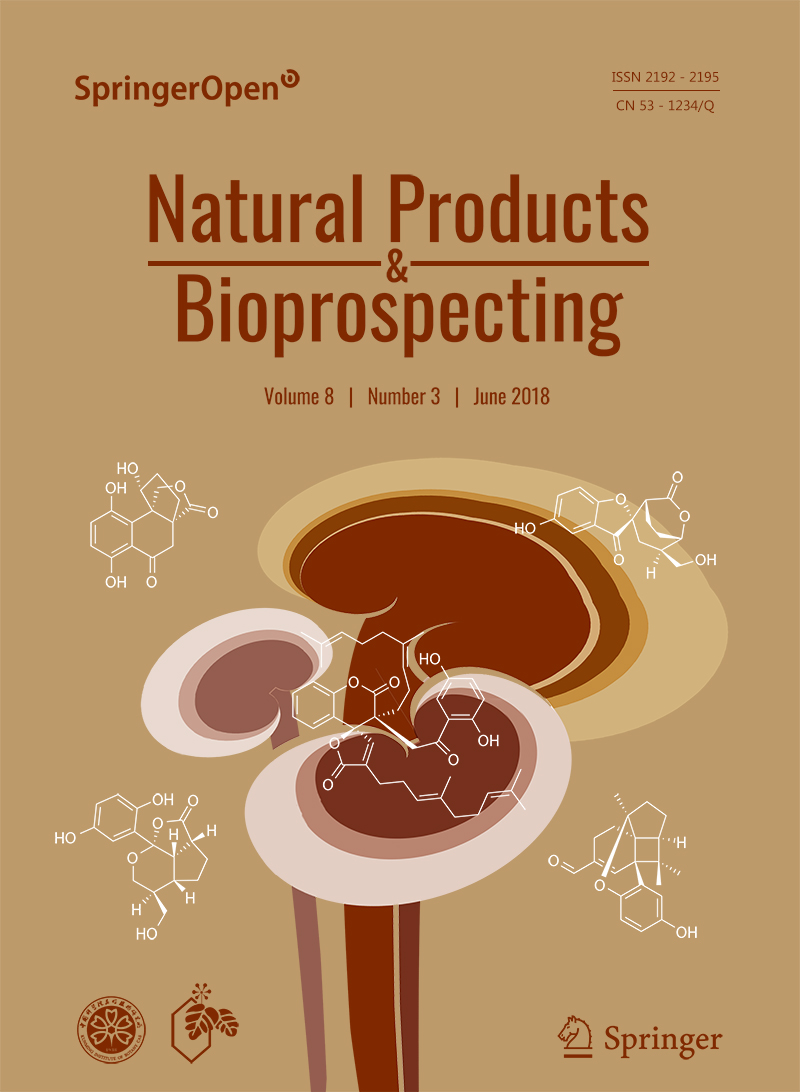|
|
Compounds from African Medicinal Plants with Activities Against Selected Parasitic Diseases: Schistosomiasis, Trypanosomiasis and Leishmaniasis
Collect
Conrad V. Simoben, Fidele Ntie-Kang, Sergi H. Akone, Wolfgang Sippl
Natural Products and Bioprospecting. 2018, 8 (3): 151-169.
DOI: 10.1007/s13659-018-0165-y
Parasitic diseases continue to represent a threat on a global scale, particularly among the poorest countries in the world. This is particularly because of the absence of vaccines, and in some cases, resistance against available drugs, currently being used for their treatment. In this review emphasis is laid on natural products and scaffolds from African medicinal plants (AMPs) for lead drug discovery and possible further development of drugs for the treatment of parasitic diseases. In the discussion, emphasis has been laid on alkaloids, terpenoids, quinones, flavonoids and narrower compound classes of compounds with micromolar range activities against Schistosoma, Trypanosoma and Leishmania species. In each subparagraph, emphasis is laid on the compound subclasses with most promising in vitro and/or in vivo activities of plant extracts and isolated compounds. Suggestions for future drug development from African medicinal plants have also been provided. This review covering 167 references, including 82 compounds, provides information published within two decades (1997-2017).
References |
Related Articles |
Metrics
|
|
|
Irpexoates A-D, Four Triterpenoids with Malonyl Modifications from the Fruiting Bodies of the Medicinal Fungus Irpex lacteus
Collect
Yang Tang, Zhen-Zhu Zhao, Zheng-Hui Li, Tao Feng, He-Ping Chen, Ji-Kai Liu
Natural Products and Bioprospecting. 2018, 8 (3): 171-176.
DOI: 10.1007/s13659-018-0160-3
Four eburicane-type triterpenoids with malonyl modifications, namely irpexoates A-D (1-4), were isolated from the fruiting bodies of the medicinal fungus Irpex lacteus. The structures of the new compounds were established by extensive spectroscopic methods, including 1D and 2D NMR, HRESIMS spectroscopic analysis. Irpexoate B (2) displayed weak cytotoxicity against four human cancer cell lines (A-549, SMMC-7721, MCF-7, SW480) with IC50 values varying from 22.9 to 34.0 μM, and irpexoate D (4) showed weak cytotoxicity against the human cancer cell line SW480 with an IC50 value of 35.2 μM.
References |
Related Articles |
Metrics
|
|
|
Lycoplanines B-D, Three Lycopodium Alkaloids from Lycopodium complanatum
Collect
Zhi-Jun Zhang, Qin-Feng Zhu, Jia Su, Xing-De Wu, Qin-Shi Zhao
Natural Products and Bioprospecting. 2018, 8 (3): 177-182.
DOI: 10.1007/s13659-018-0161-2
A novel C17N Lycopodium alkaloid (LA), lycoplanine B (1), containing an unusual formyl group, along with two new LAs, lycoplanines C (2) and D (3), were isolated from the whole plant of Lycopodium complanatum. Their structures were elucidated by extensive NMR techniques, including 1D-and 2D-NMR experiments, as well as comparing their spectral data with those of the known analogues. A possible biogenetic pathway for 1 was also proposed.
References |
Related Articles |
Metrics
|
|
|
Three New Indole Alkaloids from Tabernaemontana divaricata
Collect
Yan Deng, Mei-Fen Bao, Bao-Bao Shi, Jing Wu, Xiang-Hai Cai
Natural Products and Bioprospecting. 2018, 8 (3): 183-188.
DOI: 10.1007/s13659-018-0166-x
Three new monoterpene indole alkaloids, 3α-hydroxymethyl-ibogamine (1), 3α-acetatemethoxyl-ibogamine (2), 16α-hydroxyl-ibogamine (3) together with six known alkaloids were isolated from the branches and leaves of Tabernaemontana divaricata (Apocynaceae). The structures of these alkaloids were determined by spectroscopic analyses. All isolated compounds showed no significant cytotoxicity against SGC-7901 gastric cancer, HeLa, and A-549 lung cancer cell lines(IC50>20 μM).
References |
Related Articles |
Metrics
|
|
|
Anti-TMV Effects of Amaryllidaceae Alkaloids Isolated from the Bulbs of Lycoris radiata and Lycoricidine Derivatives
Collect
Dong-Qiong Yang, Zhao-Rong Chen, Duo-Zhi Chen, Xiao-Jiang Hao, Shun-Lin Li
Natural Products and Bioprospecting. 2018, 8 (3): 189-197.
DOI: 10.1007/s13659-018-0163-0
Fifteen known amaryllidaceae alkaloids were isolated from the bulbs of Lycoris radiata. Some of the compounds and lycoricidine derivatives had been screened for the activities against tobacco mosaic virus (TMV) by the conventional halfleaf method. Lycoricidine derivatives were also carried out the assay of effect on systemic infection of TMV by westernblot and RT-PCR analysis. The tested compounds showed moderate inactivation effect, whereas the lycoricidine derivatives showed good protective effect. The protective inhibitory activity of compounds L1 (N-methyl-2,3,4-trimethoxylycoricidine) (60.8%) and L3 (N-methyl-2-methoxy-3,4-acetonidelycoricidine) (62.0%) was almost similar to the positive control, Ningnanmycin (66.4%). RT-PCR and Western-blot analysis displayed that compounds L1, L3, L5 (N-allyl-2,3,4-triallyloxylycoricidine) exhibited antiviral activity, which was evidenced by reducing TMV-CP gene replication and TMV-CP protein expression. Additionally, defensive enzyme activities confirmed that compound L1 could increase the activity of PAL, POD, SOD to improve disease resistance of tobacco.
References |
Related Articles |
Metrics
|
|

